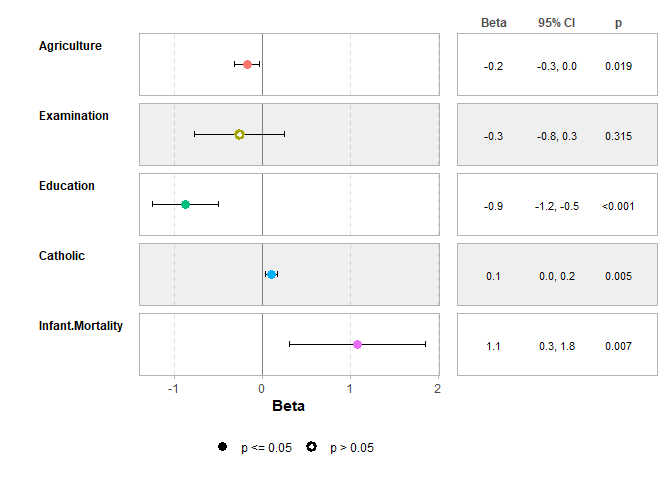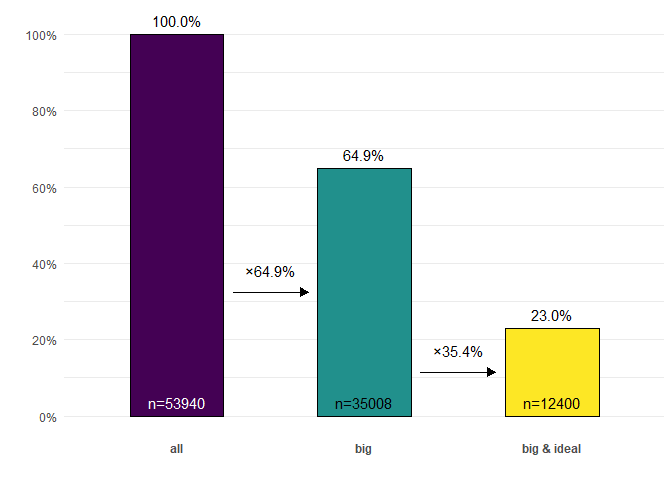
The hardware and bandwidth for this mirror is donated by dogado GmbH, the Webhosting and Full Service-Cloud Provider. Check out our Wordpress Tutorial.
If you wish to report a bug, or if you are interested in having us mirror your free-software or open-source project, please feel free to contact us at mirror[@]dogado.de.
ggstats:
extension to ggplot2 for plotting statsThe ggstats package provides new statistics, new
geometries and new positions for ggplot2 and a suite of
functions to facilitate the creation of statistical plots.
To install stable version:
install.packages("ggstats")Documentation of stable version: https://larmarange.github.io/ggstats/
To install development version:
remotes::install_github("larmarange/ggstats")Documentation of development version: https://larmarange.github.io/ggstats/dev/
library(ggstats)
mod1 <- lm(Fertility ~ ., data = swiss)
ggcoef_model(mod1)
ggcoef_table(mod1)
mod2 <- step(mod1, trace = 0)
mod3 <- lm(Fertility ~ Agriculture + Education * Catholic, data = swiss)
models <- list(
"Full model" = mod1,
"Simplified model" = mod2,
"With interaction" = mod3
)
ggcoef_compare(models, type = "faceted")
library(ggplot2)
ggplot(as.data.frame(Titanic)) +
aes(x = Class, fill = Survived, weight = Freq, by = Class) +
geom_bar(position = "fill") +
geom_text(stat = "prop", position = position_fill(.5)) +
facet_grid(~Sex)
data(tips, package = "reshape")
ggplot(tips) +
aes(x = day, y = total_bill, fill = sex) +
stat_weighted_mean(geom = "bar", position = "dodge") +
ylab("Mean total bill per day and sex")
ggplot(as.data.frame(Titanic)) +
aes(
x = Class, y = Survived, weight = Freq,
size = after_stat(observed), fill = after_stat(std.resid)
) +
stat_cross(shape = 22) +
scale_fill_steps2(breaks = c(-3, -2, 2, 3), show.limits = TRUE) +
scale_size_area(max_size = 20)
library(survey, quietly = TRUE)
#>
#> Attachement du package : 'survey'
#> L'objet suivant est masqué depuis 'package:graphics':
#>
#> dotchart
dw <- svydesign(
ids = ~1,
weights = ~Freq,
data = as.data.frame(Titanic)
)
ggsurvey(dw) +
aes(x = Class, fill = Survived) +
geom_bar(position = "fill") +
ylab("Weighted proportion of survivors")
library(dplyr)
#>
#> Attachement du package : 'dplyr'
#> Les objets suivants sont masqués depuis 'package:stats':
#>
#> filter, lag
#> Les objets suivants sont masqués depuis 'package:base':
#>
#> intersect, setdiff, setequal, union
likert_levels <- c(
"Strongly disagree",
"Disagree",
"Neither agree nor disagree",
"Agree",
"Strongly agree"
)
set.seed(42)
df <-
tibble(
q1 = sample(likert_levels, 150, replace = TRUE),
q2 = sample(likert_levels, 150, replace = TRUE, prob = 5:1),
q3 = sample(likert_levels, 150, replace = TRUE, prob = 1:5),
q4 = sample(likert_levels, 150, replace = TRUE, prob = 1:5),
q5 = sample(c(likert_levels, NA), 150, replace = TRUE),
q6 = sample(likert_levels, 150, replace = TRUE, prob = c(1, 0, 1, 1, 0))
) |>
mutate(across(everything(), ~ factor(.x, levels = likert_levels)))
gglikert(df)
ggplot(diamonds) +
aes(x = clarity, fill = cut) +
geom_bar(width = .5) +
geom_bar_connector(width = .5, linewidth = .25) +
theme_minimal() +
theme(legend.position = "bottom")
diamonds |>
ggcascade(
all = TRUE,
big = carat > .5,
"big & ideal" = carat > .5 & cut == "Ideal"
)
These binaries (installable software) and packages are in development.
They may not be fully stable and should be used with caution. We make no claims about them.
Health stats visible at Monitor.